
|   |

|   |
Dhauli - Kalinga Mahotsav 2012 - Dr. Sunil Kothari e-mail: sunilkothari1933@gmail.com Photos courtesy: Odisha Tourism December 27, 2012 Peace Pagoda at Dhauli, Bhubaneswar, was the venue of the festival under review. No sooner did the Konark Dance Festival conclude, in its wake came this unique five day Dhauli-Kalinga Mahotsav from 10th to 14th December. It had started in the year 2003 and has by now in its 9th edition, acquired such a reputation that all roads led to Dhauli peace pagoda every night. The Dhauli Fest was started by Guru Gangadhar Pradhan under the very pagoda with no support from the government while Kalinga Fest started as a tourism fest, entirely financed by the govt with the concept of martial dance suggested by dancer Ileana Citaristi. After the demise of Guru Gangadhar Pradhan, his disciple renowned Odissi exponent, choreographer, guru, administrator, Aruna Mohanty and her Orissa Dance Academy have with the Dept of Tourism and Culture, Govt. of Odisha, taken over the organization, including Martial Arts Festival within the fold of Dhauli-Kalinga Mahotsav. The festival has now acquired a multi dimension format. Various streams of classical dances, traditional performances of Odisha and martial arts have been projected in this festival in a seamless manner. This year there was an arresting statue of Lord Buddha adorning the large stage. The Peace Pagoda and the temple were lit up artistically. Daily torch was offered for peace and the inaugural function saw more than 60 dancers with lamps in their hands, dressed in white costumes with blue borders, performing on the stage. It was the most spectacular sight one could see. How Aruna and her team with ace musician Guru Ram Hari Das work out the choreography and presentation is quite mind boggling. Chief Minister Navin Patnaik inaugurated the festival, honoured the celebrated painter Jatin Das with Ruchi Buddha Samman, and with a quiet dignity, left after a while without making any speech. It was indeed refreshing to see a Chief Minister flagging off the festival in such an unassuming manner. Orissa Dance Academy presented an extraordinary performance dwelling upon the theme of 'Twelve months and Thirteen festivals,' the aspirations and love for life, celebrating each festival with typical Odiya ambience. One watched with surprise so many aspects of Odiya culture and felt rewarded for such a wonderful presentation. Poet and dance critic Kedar Mishra has penned some of the songs. The manner in which the male dancers performed and the female dancers joined them was a lesson for large scale choreography. Bravo Aruna and her dancers! 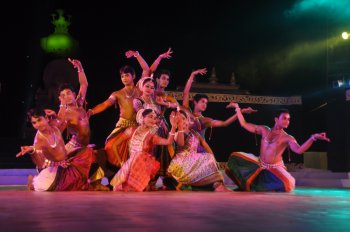 Orissa Dance Academy 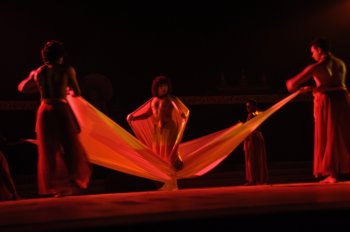 Samudra From Kerala came the high voltage dancers Madhu Gopinath and Vakkom Sajeev, who run their Samudra Centre for Indian Contemporary Performing arts at Trivandrum. They have earned a great reputation for their superb physical dance theatre, and their training in Kalaripayattu, martial arts of Kerala, is excellent. They brought with their male and female dancers, a unique choreographic work 'Jalam' on water, its boon giving elements and when turning into storm, the devastation. The subjugating of evil elements was performed with great energy. The use of cloth, white sheet blowing in the air with fascinating patterns created visuals of exquisite beauty. I am a great admirer of Madhu and Sajeev and I wish they would have someone as a sounding board for their new choreographic work, so that the rough edges could be ironed out. Their physical energy needs some moderation. But they are doing wonderful work. On 11th December, the Gotipua dancers enthralled the audiences with their various bandhas, human pyramid formations and received loud appreciation. At times, one wondered if the gotipua dancers imitating the evolved Odissi dance form are erasing the borders between original Gotipua forms. But their natural charm and age in particular of young ones, barely seven and ten, stole the hearts of the audience. 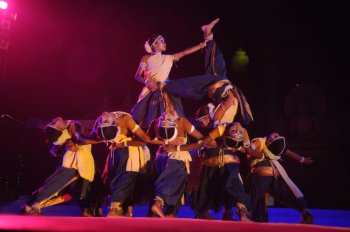 Gotipua dancers 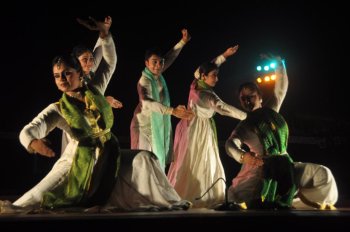 Ranan 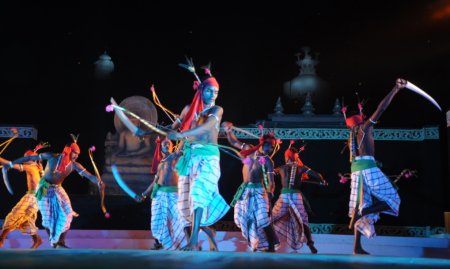 Santali From Kolkata, Ranan dance and theatre company headed by Vikram Iyengar and female dancers trained by Guru Rani Karnaa presented excellent Kathak, full of aesthetics, eye soothing costumes in pastel colours, uniform training, replete with melodious music. Even the ginati, counting one, two, three, was employed musically and did not have naked grammar. One rarely sees Tirvat composition, which they danced with Úlan. Vikram has shown a lot of improvement in his demeanor and open shoulder movements. The harmony was praiseworthy. Tagore's Bhanusingher Padabali song 'Sawana gagane ghor ghana ghata' was performed with intense abhinaya by Debashree Bhattacharya. The coordination, quick changes of costumes, entries and exits were perfect. The stamp of Rani Karnaa's aesthetic approach was evident. Well done, Ranan. On 12th December evening, once again we were transported to wonderful musical soundscape titled Mahodadhi with orchestra by Badya Banee, Bhubaneswar (which I have reviewed when I saw it during Meera Das's Gunjan Dance Academy Festival this November). It looked impressive with so many musicians and imaginative composition in terms of instrumental music and percussion extravaganza. Gurus Ram Hari and Dhaneswar Swain deserve congratulations. Santali Danta from Rairangapur enchanted all with their fantastic drum playing. Famous for their Saharaya Festival in Dharm Akhada, Dusmanta Basa, a promising tribal young dancer, the leader of the Santali Danta Troupe, displayed his gifts highlighting this rare art.
From Kolkata, Sharmila Biswas and her troupe of Odissi Vision and Movement Centre offered unusual fare. Because the choreographer's note was not understood by me, I requested her to send me her notes. And lo and behold, I gathered a wealth of information. Since 2000, she has been exploring Sambalpuri music, dance and art traditions. Her principal guide was late Murari Mohan Mishra. Others like singer and composer Dukhishyam Tripathy, Ranjan Sahu, Shashankashekhar Dubey and Mahesh Mishra continue to guide Sharmila in her work. The main material for 'Devi Bharani' was collected by her in 2000, but she gave a dance concept in Odissi as a Mangalacharan and not as a ritual. She kept the original flavor but deviated as per the need of Odissi dance. The ritual is not performed in the Sambaleshwari temple. The sets of rhythms played to invoke the spirit of Devi in the medium are often described as Shohla Bharani. Traditionally, 16 sets of rhythms were played. There were 3 and 4 beats, layering with two sets of Bharani baja. Sharmila added Chandi Mantra, a sloka on Devi. Malashree refers to the song and sabda, verses accompanied by rhythm when the Devi actually enters the medium. Sharmila also has chosen 14 beats song Arata Tarini Maa in 14 beats, with changes appropriate for Odissi dance. She did not have predictions by the medium but replaced it with Sabha Pranam to complete the structure of Mangalacharan. In choreographic work Trikayee, she has received assistance from Krushnachandra Sahoo and troupe for Prahlada Nataka. She has not taken the spectacular aspect of the form but followed the music composition and with the help of Pandit Madhup Mudgal got the music composed for her choreography. It was a deliberate decision to sing Alaap and concluding Alaap as close to the style. The original raga Sindhu Khamvaj was used with stylized variation. The young musician who sat on the stage with two dancers recreating solfa notes after his Alaap singing, was visually interesting, as on other side a drummer with two dancers executed movements of playing percussion instruments and a solo dancer performed in the centre stage. Since it was a vast open air stage, the solo dancer had to cover the space and it posed problems for dancers to manage physical space almost running all over. The choreography would have been seen in better light in a proscenium stage since the dancers did not have time to re-choreograph the piece. Individual autonomy in terms of rhythm music and dance was well maintained. It would be interesting to see this work on a proscenium stage. 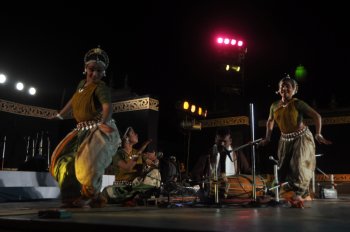 Sharmila Biswas & group 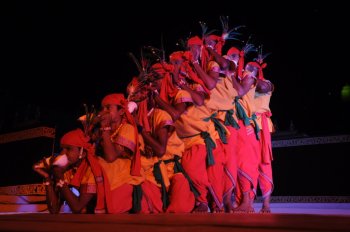 Sankhadhwani In Pancharasavali taking ashtapadi 'Kelisadane pravish Radhe,' Sakhi cajoling, pushing Radha, at times getting angry, leading Radha to the bower where Krishna was awaiting her. Personally, I found Radha's hesitation, rolling on the floor etc., as 'over the top' abhinaya. It could have been more suggestive to maintain the high philosophical concept, as Sharmila interpreted the union of Radha and Krishna as that of Jivatma and Paramatma and juxtaposing Vishwarupa of Krishna as revealed to Arjuna in Mahabharata war. Using philosophy of Gaudiya Vaishnavism where in Jayadeva's Gita Govindam, Bilwamangal's Krishnakarnamrutam, Padabalis of Chandi Das and Vidyapati have common meeting ground, Sharmila attempted three main principles of Pancharasa tatwa as explained by Sri Chaitanya who expounds shringara rasa to five fold path viz., Saanta, Daasya, Sakhya, Vaatsalya and Madhura. Sharmila mentions that Abhimanyu Samanta Sinhara describes the union of Radha and Krishna as 'aprakrita' meaning 'beyond sensual experience.' She ended the performance with only possible conclusion which makes love a spiritual experience that is far beyond the sensual pleasure. Therefore for her, Gita's words are 'shashwat' and 'Pravad Vakya' and NOT only description of a scene from Mahabharata. The confusion started with enactment of Krishna's announcement to the effect that he was 'Airavata, Sun, Moon, O Arjuna,' for viewers including me as a critic. Maybe Sharmila would work out a possible solution to make this philosophic concept merge in a seamless manner. As a choreographer and a seasoned dancer trained by none other than Kelucharan Mohapatra, Sharmila explores various facets of Odiya culture and presents before Odiya people, at times sticking her neck out. But that is where her strength lies as a constantly evolving dancer with an artistic vision. If I have written all this at such length, I have done it with a purpose. Such large scale festivals need to give to critics and connoisseurs, choreographers' notes to enable them to relish the work in right perspective. I mention this because for even Konark Dance Festival the choreographers' notes were not published in the booklet. Someone has to make this aspect very professional and someone has to undertake responsibility of editing the text in the program booklet. In Chennai, the Music Academy brings out a souvenir mentioning the ragas to be performed by the musicians. Audiences then are ready to enjoy the program. It may sound difficult, but it is not so. When so much money is spent on several aspects of presenting dance on site specific venues, it is imperative that money be allocated to exclusive editing of the program booklet, which then serves as a reference guide for public and critics. Else dancers' choreographic works may receive incorrect impression. Gatka Dance by Shaheed Baba Deep Singh Ji Gatka Academy from Chandigarh took the audience by surprise with their dynamic exposition of combats with various weapons, their victorious cheers of 'Vahe Guru' and 'Khalsa' electrifying the atmosphere beyond words. Rarely has one seen such performances. The cutting of a pumpkin placed on the stomach of a soldier by a blindfolded soldier, of breaking a coconut placed on the head of a soldier etc, were amazing feats. Similar feats are also seen in Thang-Ta martial arts of Manipur. Our hearts were in our mouths watching these. The company from Chandigarh showed their versatility. The message was clear that the instruments of war have to be used for peace. 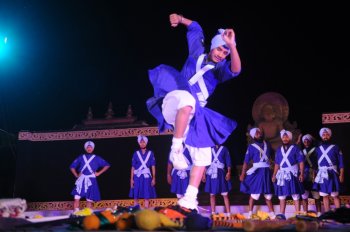
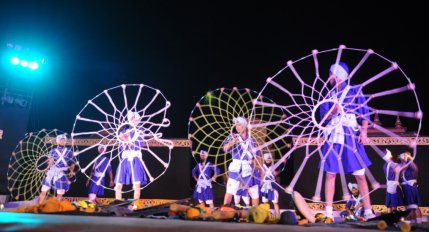
On 13th December Sankhadhwani by Sankhadhwani Kala Kendra, Ganjam, conducted by Rajendra Mohapatra blew the conches with amazing lung power and like Gotipua dancers formed human pyramids of various acrobatic nature winning rounds of applause. It was interesting to watch these traditional performing arts being projected in this festival. The celebrated Bharatanatyam dancer and choreographer Anitha Guha from Chennai brought her versatile disciples including the brilliant male dancer Pavitra Bhat, her and Deepak Majumdar's disciple, and stole the show with excellent choreographic presentations. The group dances were well synchronized, movements arresting, dancers of equal heights, thematic presentation of Vedachala and other sacred sites of Tirupati temple woven in a flawless manner, dancers performing joyously with clean geometrical lines of Bharatanatyam. The concluding teermanams executed artistically showed Anita Guha's imaginative approach. The tillana danced by all in unison, offering a visual treat brought down the house. So different from dominating Kalakshetra bani, Anitha's Bharatanatyam style left an indelible impression. That the form of Bharatanatyam can offer such variety was an eye opener for many in the audience. Anitha Guha's works deserve to be watched in major national and international festivals. Though I have been watching dance for past forty years and more, it was only in January this year in the Music Academy's dance festival at Chennai that I saw her work and was impressed and wondered how I had missed her work! Now that I have seen her work twice in different venues, I look forward to watching her troupe in other national festivals. 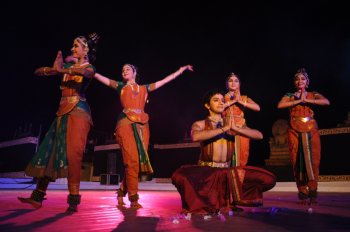 Anitha Guha's group 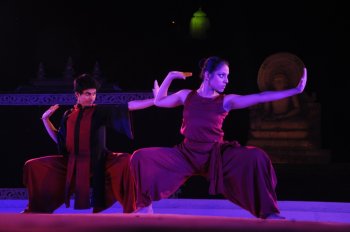 Attakkalari Anitha Guha's presentation was followed by the choreographic excerpts of Attakkalari Centre for Movement Arts, Bengaluru. The choreographer, dancer Jayachandran Palazhy could not attend on account of other commitments. His mission is to make dance accessible to all sections of society, to empower young artists by giving them necessary tools and training that will enable them to create fresh physical vocabulary related to their experiences, memories and thoughts. The troupe presented breathtaking movements based on Kalaripayattu metamorphosed in various combinations, male and female dancers dancing with great physical command, thorough training and superb stamina. I have already reviewed MeiDhwani work in my column previously. Its abbreviated version with spotless stainless pots, dancers using them as props, looked fascinating. The demanding physical movements at times looked repetitive, as one watches them often in contemporary dance. There were some 'quotations' of familiar Bharatanatyam hastas and adavus, but overall it was pure movement and executed in a manner which kept audiences wondering at their fantastic training. On 14th December, the classical Odissi group choreographic work of Guru Durgacharan Ranabir's Nrutyayan was presented. He is carrying on Guru Deba Prasad Das gharana. He presented the story of Lord Buddha renouncing the world having seen the four stages of youth, old age, sickness and death, with exquisite composition of a chariot, driven by horses, young prince Siddhartha played with restraint by Rahul Acharya, the charioteer explaining to Siddhartha, the process of life and death, and in the finale, all going to Lord Buddha chanting "Buddham saranam gachhami." The dancers led by Rahul Acharya, went to the statue of Lord Budhha, creating stunning visual. Guru Durgacharan Ranbir played the roles of old man, sick man with leprosy. The sequence of death struck familiar notes from one's own life. 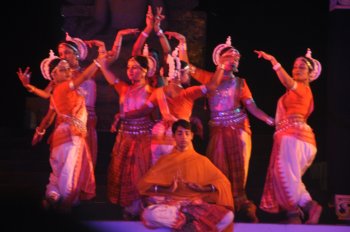 Nrutyayan 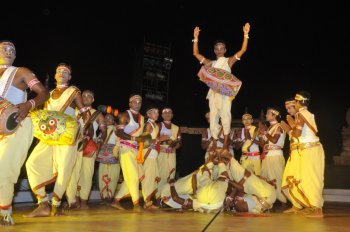 Patitapabana Odissi Shankirttan Mandali Before their presentation, Shankrittan (Dashabatara) by Patitapabana Odissi Shankirttan Mandali, Pipli, Narendra Pattashani charmed audiences with their playing on khol and using large cymbals. Italian Odissi and Mayurbhanj Chhau exponent, choreographer, dancer Ileana Citaristi presented Mayurbhanj Chhau dancers from Utkal Sangeet Vidyalaya and artists of Ma Aanlei Paik Akhada Academy of Khurda in 'Samar Taranga' juxtaposing two martial art forms. They displayed their respective characteristic martial arts vigorously. There were some meeting points in movements, and martial traits were noticed. But like Mayurbhanj Chhau has acquired a semi classical status, I wonder how Paika artistes shall rise to that artistic level for the patronage has been meager and imaginative choreography needs to be developed. Ileana has done excellent research work on this tradition and has published a book also. It was a laudable attempt, but needs more work in terms of choreography for stage presentation. 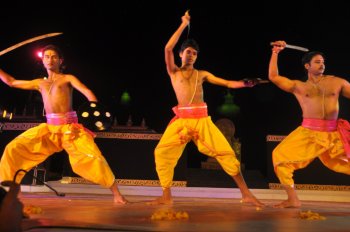 Samar Taranga 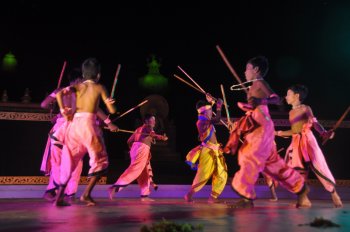 Laudi Loka Nrutya The Laudi Loka Nrutya by Laudi Research Centre, Bideipur, Bhadrak by Nityananda Das was the penultimate presentation. Nityananda is a differently abled dancer and teacher of high repute. He lost his right leg in a road accident, but with tremendous will power he performs with one leg and has popularized Laudi and other folk dances. His group performed with enthusiasm and one could see that he has trained the young dancers well. Their stick dances were flawless. The final number was the most popular Gitinatya of Kanchi Kaveri by Gopal Das Memorial Cultural Organization. The story is well known and the milk maid who sells curd to two persons, Lord Jagannath and Balaram in disguise, sang soulfully, with audience cheerfully applauding her. Lord Jagannath gives her a ring and tells her that the king will come and she will be paid if she shows the ring to the king. When she meets the king, he tells her that it was Lord Jagannath who had given the ring. The milk maid is overwhelmed. As a shared tradition the well known story has a happy ending, with actors singing and delivering dialogues. Though it had touches of Jatra presentation, its popularity was evident and its inclusion in the festival brought the form closer to public. I was delighted to watch it as though I knew the story I had not seen Gitinatya form. Dhauli-Kalinga festival has, like Konark Dance Festival, become a very popular festival with record crowds every night. I was told that the organizers had made arrangements for young students to attend it and transport was provided. We noticed that for contemporary dance and martial arts of Gatka and folk forms the students applauded the performances showing their enthusiasm. This is an excellent initiative and I congratulate the organizers. The Indian Institute of Technology, ITER Siksha 'O' Anusandhan University, Silicon Institute of Technology, Xavier Institute of Management, KITTS Deemed University and other educational institutes cooperated by sending their students to the festival, thereby creating an interest among younger generation in our cultural heritage. Orissa Dance Academy deserves congratulations for organizing the festival with the help of Dept of Tourism and Culture, Govt. of Odisha. The principal Secretary Mr. A K Tripathy has been lending generous support for the festivals making Odisha a land of festivals. The support from the local dancers has been exemplary. While Konark Dance Festival offers an excellent fare of classical dances, the Dhauli-Kalinga Festival has a lager canvas including popular folk art forms which need support.  Dr. Sunil Kothari is a dance historian, scholar, author and a renowned dance critic. He is Vice President of World Dance Alliance Asia Pacific India chapter, based in New Delhi. He is honored by the President of India with Padma Shri, Sangeet Natak Akademi award and Senior Critic Award from Dance Critics Association, NYC. He is a regular contributor to www.narthaki.com, the roving critic for monthly magazine Sruti and is a contributing editor of Nartanam for the past 11 years. Post your comments Pl provide your name and email id along with your comment. All appropriate comments posted with name and email id in the blog will also be featured in the site. |